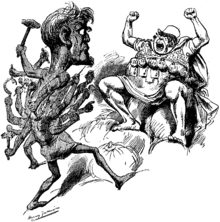Hecatoncheires
_Flaxman_Ilias_1793%2C_gestochen_1795%2C_185_x_251_mm.jpg)

The Hecatoncheires[note 1] (In English, stress on the fourth syllable;[1][2] singular: Hecatoncheir /ˈhɛkəˌtɒŋkər/; Greek: Ἑκατόγχειρες Hekatonkheires 'Hundred-Handed Ones'), also called the Centimanes /ˈsɛntɪˌmeɪnz/ (Latin: Centimani) or Hundred-Handers, were figures in the archaic, pre-Olympian era within Greek mythology, three giants of incredible strength and ferocity that surpassed all of the Titans, whom they helped overthrow. Their name derives from the Greek ἑκατόν (hekaton, "hundred") and χείρ (cheir, "hand"), "each of them having a hundred hands and fifty heads" (Bibliotheca 1.1). Hesiod's Theogony (624, 639, 714, 734–35) reports that the three Hecatoncheires became the guards of the gates of Tartarus. The Hundred-Handed-Ones are "giants" of great storms and hurricanes.
In Virgil's Aeneid (10.566–67), in which Aeneas is likened to one of them (Briareos, known here as Aegaeon), they fought on the side of the Titans rather than the Olympians; in this, Virgil was following the lost Corinthian epic Titanomachy rather than the more familiar account in Hesiod.
Other accounts make Briareos (or Aegaeon) one of the assailants of Olympus. After his defeat, he was buried under Mount Aetna (Callimachus, Hymn to Delos, 141).
Mythology
Hesiod
According to Hesiod, the Hecatoncheires were children of Gaia (Earth) and Uranus (sky).[3][4] They played no known part in cult.[5] They were:
- Briareos (Βριάρεως) "Strong",[6] also called Aegaeon (Αἰγαίων), spelled in Latin as Briareus[7]
- Kottos (Κόττος) "Strike, punch"[8]
- Gyges (Γύγης) or Gyes (Γύης), possibly "limb" or "curved"[9]
During the War of the Titans, the Hecatoncheires fought against the Titans, throwing rocks as big as mountains, one hundred at a time, and overwhelming them. After this, the Hecatoncheires became the guards of Tartarus. Briareos became the son-in-law of Poseidon, who gave him "Kymopoliea his daughter to wed".[10]
Pausanias
In a Corinthian myth related in the second century CE to Pausanias, Briareos was the arbitrator in a dispute between Poseidon and Helios, between sea and sun: he adjudged the Isthmus of Corinth to belong to Poseidon and the acropolis of Corinth (Acrocorinth) sacred to Helios.[11]
Others
Scholia (manuscript notes) on Apollonius of Rhodes represent Aegaeon as a son of Gaea and Pontos, the Sea, ruling the fabulous Aegaea in Euboea, an enemy of Poseidon and the inventor of warships.[12] In Ovid's Metamorphoses and in Philostratus' Life of Apollonius of Tyana he is a marine deity.[13]
In literature
- In the first book of Homer's Iliad (c. 700 BC), Achilles asks his mother to appeal to Zeus on account of a previous interaction with Briareus, or Aegaeon.
- Briareus is mentioned twice in Dante Alighieri's Divine Comedy (completed 1320); he is first found as a giant inhabiting the ninth circle of Hell[14] and then again as an example of pride, carved into the pavement of the first terrace of Purgatory.[15]
- In Rabelais' five-part novel Gargantua and Pantagruel (finished 1564) it is mentioned that a waiter needs as many hands as "Briareus".[16]
- Briareus is also mentioned in Cervantes' Don Quixote (1615), in the famous episode of the windmills.
- Briareus is mentioned in Book I of John Milton's Paradise Lost (1667) alongside Typhon as an analog to the fallen Satan.
- Briareus is mentioned in The History of Tom Jones, a Foundling (1749), by Henry Fielding, in a conversation between Tom Jones and Mr. Partridge (Book 8, Chapter IX).
- Kottos, styled as Cottus, is mentioned in John Keats' fragment Hyperion (1819) as a brooding deity in the aftermath of the Titanomachy.
- In Canto VI of his satiric poem Don Juan (completed in 1824), Byron makes a slightly crude joke, musing whether "enviable Briareus […] with thy hands and heads […] hadn't all things multiplied in proportion" (this thought arising from Byron's assertion of his love of all womankind in the previous canto).
See also
Notes
- ↑ Depending on the method of transliteration, the Ancient Greek ἑκατόν (hekaton) may be latinised as hecaton and χείρ (cheir) may be transliterated as kheir, chir or even khir.
References
- ↑ Howatson, M.C. (2013). "Hecatoncheiʹres". The Oxford Companion to Classical Literature. Oxford University Press. p. 277.
- ↑ Bulfinch, Thomas (1902). "Hec-atonchiʹres". The Classic Myths in English Literature. Ginn & Co. p. 508.
- ↑ Hesiod calls them the "Ouranids" (Theogony 502).
- ↑ A scholia on Apollonius Rhodius 1.1165c notes "Eumelos in the Titanomachy says that Aegaeon was the son of Earth and Sea, lived in the sea, and fought on the side of the Titans"; noted in M.L. West "'Eumelos': A Corinthian Epic Cycle?" The Journal of Hellenic Studies 122 (2002, pp. 109–133) p 111.
- ↑ Kerenyi 1951:19
- ↑ Liddell, Scott & Jones, A Greek–English Lexicon, sv.Βριάρεως & βριαρός
- ↑ See Virgil, Aeneid 6.287: "et centumgeminus Briareus ac belua Lernae"
- ↑ Liddell, Scott & Jones, A Greek–English Lexicon, sv. κόσσος
- ↑ Beekes, Etymological Dictionary of Ancient Greek, sv.γύης
- ↑ Hesiod, Theogony 817.
- ↑ Pausanias, Description of Greece 2.1.6 and 2.4.7
- ↑ Apollonius, Argonautica 1,1165
- ↑ Ovid, Metamorphoses 2.10; Philostratus, Life of Apollonius 4.6
- ↑ Dante, Inferno XXXI.99.
- ↑ Dante, Purgatorio XII.28.
- ↑ Rabelais, Francois (1955). "5". Gargantua and Pantagruel. Great Britain: Penguin Classics. p. 50. ISBN 014044047X.
Bibliography
| Wikisource has the text of the 1911 Encyclopædia Britannica article Briareus. |
| Wikimedia Commons has media related to Hecatonchires. |
- Hesiod's Theogony, 147ff.
- Bibliotheca I.1.1
- Ovid, Fasti iv.593
- Horace Carminae II.17.14, III.4.69
- Karl Kerenyi, Gods of the Greeks, London, Thames and Hudson, 1951.
- Theoi Project - Briareos